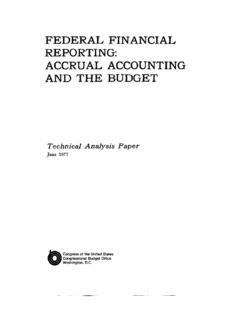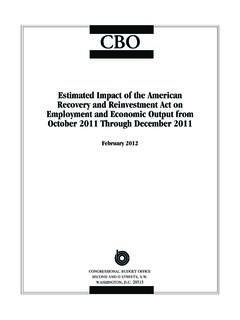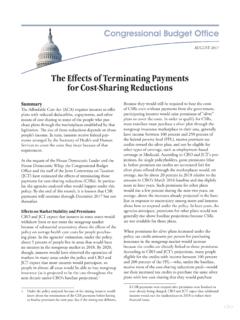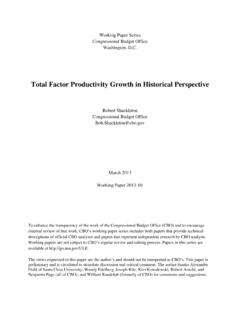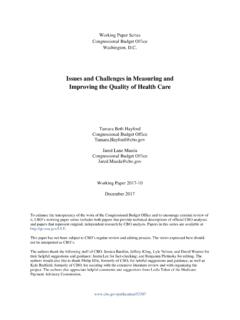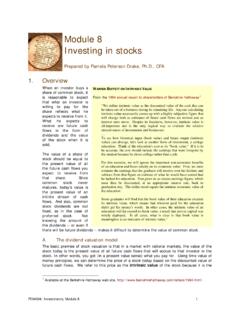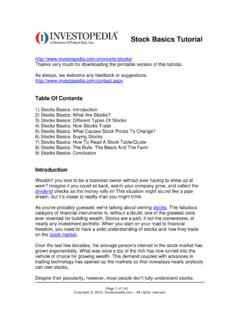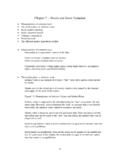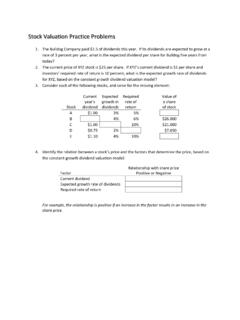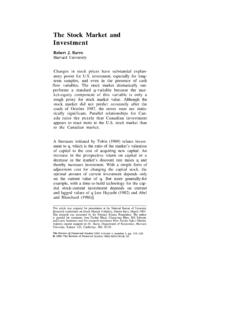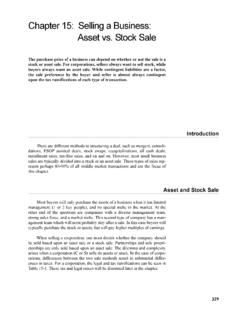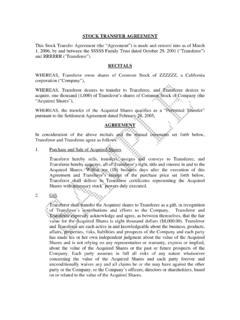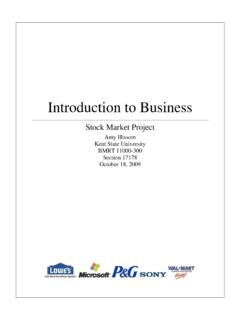Transcription of Accounting for Employee Stock Options
1 CONGRESS OF THE UNITED STATESCONGRESSIONAL BUDGET OFFICEAPAPERAPRIL 2004 Accounting forEmployeeStock OptionsCBOE yewire/GettyImagesThe Congress of the United States O Congressional Budget OfficeCBOA ccounting for Employee Stock OptionsApril 2004 APAPERP refaceIn March 2003, the Financial Accounting Standards Board (FASB) began reconsidering the Accounting standard for equity-based compensation. The Accounting board released an expo-sure draft for a revised standard on March 31, 2004. That revised standard would require firms to recognize the fair value of Employee Stock Options as an expense, as was first proposed by FASB more than 10 years ago. This Congressional Budget Office (CBO) paper assesses whether, under the current account-ing standard, firms that grant Employee Stock Options without recognizing an expense over-state their reported income. The paper presents the relevant issues, describes the current standard for Employee Stock Options , compares the intrinsic value and fair value methods of measurement, and weighs the potential economic effects of revising the current standard.
2 The report was prepared at the request of Congressman Brad Sherman in his capacity as a member of the House Committee on Financial S. Ruud of CBO s Microeconomic and Financial Studies Division prepared the paper under the direction of Roger Hitchner and Marvin Phaup. Early investigation of the subject was conducted by Douglas Gruener, a summer intern at CBO. George J. Benston of Emory University and Deborah Lucas of Northwestern University reviewed a draft of the paper and provided valuable suggestions. Wendy Kiska, Angelo Mascaro, David Torregrosa, Philip Webre, and Thomas Woodward, all of CBO, also provided helpful comments. Christine Bogusz and Leah Mazade edited the paper, and John Skeen proofread it. Maureen Costantino prepared the paper for publication and designed the cover, and Annette Kalicki produced the electronic versions for CBO s Web site ( ).
3 Douglas Holtz-EakinDirectorApril 2004 Summary viiThe Key Issue: Intrinsic Versus Fair Value 1 The Current Accounting Standard 2 FASB s Proposal 3 Why Firms Grant Stock Options 3 Potential Economic Effects of Fair Value Recognition 4 Valuing and RecognizingEmployee Stock Options 5 The Difficulty of Measuring the Value ofEmployee Stock Options 5 When Should the Value of EmployeeStock Options Be Measured? 7 When Should the Expense of Employee Stock Options Be Recognized? 8 Comparing Accounting Alternatives: An Example 8 Granting Cash, Stock , and Purchased Call Options as Compensation 8 Granting Employee Stock Options in Lieu ofEquivalent Cash Compensation 10 Letting Options Expire or Exercising Them 11 The Bottom Line: Reporting DifferencesBetween the Two Accounting Methods of Accounting Treatments for Selected Formsof Compensation: Cash, Stock , and Purchased Call of Accounting Treatments for Employee Stock of Accounting Treatments for Employee Stock Optionsat Accounting Employee Stock Options Differ from Call Options6 SummaryCurrent Accounting standards require firms to recognize as an expense (deduct from their income) the value of the compensation they provide in the form of Employee Stock Options .
4 For some types of Employee Stock Options they grant, however, firms can choose how to measure that value. They can use the immediate-exercise value (intrin-sic value), which is usually zero, or an estimate of the market value (fair value), which is almost always greater than zero. As a result, firms may assign a cost of zero to that portion of compensation made up of grants of em-ployee Stock Options . That practice results in overstate-ment of reported net income. In March 2003, the Financial Accounting Standards Board (FASB), the private-sector organization that sets standards for financial Accounting and reporting in the United States, announced that it would reconsider the ac-counting standard for equity-based compensation. On March 31, 2004, FASB released an exposure draft that proposes revising the standard to require not merely en-courage firms to recognize the fair value of all Employee Stock Options as compensation expense for financial-reporting purposes.
5 The prospect of that revision has gen-erated considerable analysts argue that requiring firms to recognize as an expense the fair value of Employee Stock Options is un-necessary or ill-advised. Underpinning those arguments are different assumptions about whether the information on fair value is currently transparent to users of financial who believe that information about fair value is adequately transparent consider it unnecessary to change the current standard. Although information about fair value is not reflected in net income, it is already available to investors in the notes to firms annual financial reports. (In those notes, firms must disclose the fair value of the grants of Employee Stock Options for which they recog-nized the intrinsic value.)Other observers maintain that recognizing the fair value of Employee Stock Options is ill-advised because that in-formation is not now transparent and making it so could have negative consequences.
6 Recognition might reveal new information to investors that could drive down the Stock prices of firms that grant Employee Stock Options . That result could in turn damage the economy, some an-alysts other analysts oppose the recognition of the fair value of Employee Stock Options on more basic grounds. For example, they assert that the value of those Options cannot be estimated reliably and that recognizing an esti-mate of the expense would reduce the accuracy of re-ported net income. Others oppose recognition because they do not view the granting of Employee Stock Options as an expense to the firm at all but simply a redistribution of Congressional Budget Office s (CBO s) analysis of this Accounting issue comes to the following conclusions:BIf firms do not recognize as an expense the fair value of Employee Stock Options , measured when the Options are granted, the firms reported net income will be in the value of Employee Stock Options after they have been granted as well as the exercising of those Options are irrelevant to a firm s income state-ment because they affect shareholders directly, not the firm itself.
7 Specifically, they transfer wealth from exist-ing shareholders to holders of Employee Stock complicated to calculate, the fair value of Employee Stock Options may be estimated as reliably as many other the fair value of Employee Stock Options is unlikely to have a significant effect on the economy (because the information has already been disclosed); however, it could make fair value information more transparent to less-sophisticated for Employee Stock OptionsFor more than 50 years, organizations that set ac-counting standards have espoused the principle of mea-suring the fair value of Employee Stock Options provided as part of a compensation package and recognizing that value as an operating expense. Businesses that adhere to that principle subtract the Options fair value the esti-mated amount for which the Options could be bought or sold in a current transaction from their revenue in de-termining their earnings, which are reflected on their in-come statements (see Box 1).
8 The information provided by the income statements and by other financial report-ing and disclosures is used by investors and others outside the firms who are seeking to assess their to require firms to recognize the fair value of Employee Stock Options as an expense the current stan-dard encourages but does not require that practice have been put forward in the past, provoking significant con-troversy. The central concern driving such proposals was expressed as early as 1953 by the Committee on Account-ing Procedures (the Accounting standards board of that era):To the extent that such Options and rights [that is, Options to purchase or rights to subscribe for shares of a corporation s capital Stock ] involve a measurable amount of compensation, this cost of services received should be accounted for as such. The amount of compensation involved may be substantial and omission of such costs from the corporation s Accounting may result in overstate-ment of net income to a significant issue of requiring firms to recognize the fair value of Employee Stock Options was raised most recently in March 2003 when the Financial Accounting Standards Board (FASB) the independent private-sector board that currently sets financial Accounting standards announced that it planned to reconsider the current stan-dard for equity-based compensation.
9 This Congressional Budget Office (CBO) paper describes the issues that sur-round the debate about changing that standard, analyzing the current Accounting requirement, the arguments ad-vanced for and against requiring fair value recognition, and how such a change might affect the economy. The re-port also compares the methods now being used to value Employee Stock Options , presenting a detailed example to illustrate the general effects of those Key Issue: Intrinsic VersusFair Value In 1993, FASB recommended a change in the Accounting treatment of Employee Stock Options . It proposed that firms recognize the fair value of the Options (measured when the Options are granted) as an expense on their in-come statements over the period in which employees per-form the services for which the Options serve as compen-sation. (That period usually corresponds to the vesting period the waiting period most companies require be-fore the option holder may exercise the option.)
10 How-ever, FASB s proposal encountered severe opposition, mostly from the managers of firms granting such Options . Those managers preferred to continue to use the account-ing treatment permitted under what was then the current standard that is, to recognize the intrinsic (or immedi-ate-exercise) value of Employee Stock Options rather than the Options fair Their preference derived at least in part from the fact that at the time Options are granted, the intrinsic value is almost always less than the fair value and thus a smaller amount is subtracted from firms Committee on Accounting Procedures, Compensation Involved in Stock Option and Stock Purchase Plans, Accounting Research Bulle-tin No. 43 (1953), Chapter That treatment was established in 1972 by FASB s predecessor, the Accounting Principles Board, in its Opinion No. 25, Accounting for Stock Issued to Employees (referred to hereafter as Opinion 25).
